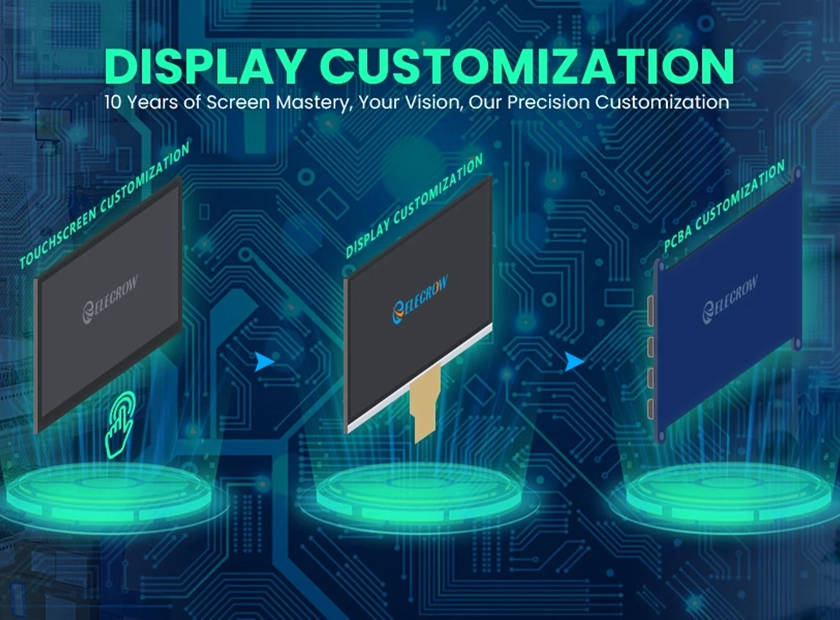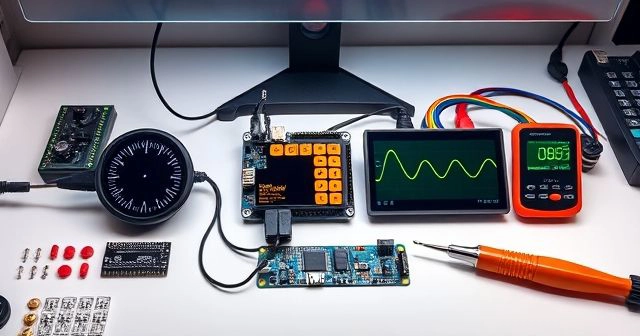How Custom Screens Are Leveling Up DIY Electronics

For the passionate open-source hardware enthusiasts and DIY Makers among us, the display screen is the crucial window that brings our creations to life and enables cool interactions. Whether crafting a unique personal weather station, a retro gaming handheld, or an interactive art installation, the right screen often dictates the project's success and its ultimate "cool factor." However, for too long, we've often been constrained by the standardized, cookie-cutter display modules readily available. Wanting to break the mold and use a screen with a specific size, shape, or a particular interface? In the past, this usually meant facing daunting challenges or compromises, limiting brilliant ideas – ideas that a modern custom display service could now enable.
But times are changing, and technology is advancing. Today, a more flexible and friendly custom display service is emerging, bringing previously out-of-reach customization capabilities within the grasp of everyday hobbyists like us. Its core value, as a custom display service, lies in offering deeply personalized technical options that go far beyond off-the-shelf products. Now, you no longer need to modify your meticulously designed 3D-printed enclosure just because you couldn't find the right screen; a good custom display service allows you to specify the exact screen dimensions, even circular, strip-like, or other irregular shapes, to perfectly match your structural design. Interface choices are also freer, thanks to the options provided by a custom display service; it's become much easier to get screens with MIPI DSI interfaces natively compatible with Raspberry Pi, or SPI interfaces convenient for connecting to microcontrollers (MCUs) like ESP32 and Arduino, significantly simplifying hardware connections and software driver complexity. Furthermore, features like touch functionality, custom cover glass, and full lamination processes are all becoming available as selectable options, typically offered by a comprehensive custom display service. This kind of custom display service lets you truly build your unique project, starting right from the screen itself.

Diverse Custom Screens
But "customizable" is one thing; making it genuinely easy for enthusiasts to leverage this custom display service is the real game-changer. The appeal of this custom display service lies precisely in its flexibility and accessibility tailored to individual needs. It provides a technical solution, a key aspect of any good custom display service, allowing hobbyists to focus on realizing their creative vision instead of being bogged down by the limitations of standard components. By offering one-stop support – a hallmark of a user-friendly custom display service – from screen selection assistance to technical details, it significantly lowers the technical barrier to integrating custom displays via a custom display service. It's like unlocking a powerful component "toolbox," made accessible by the custom display service, for the wider enthusiast community.
So, just how deep can this customization go when utilizing a custom display service? Looking at different types of hobbyist projects reveals the magic – the following example feature comparison table illustrates how various maker endeavors might leverage the technical capabilities offered by such customization services. Many of the options shown (interfaces, touch, cover glass treatments) can be found referenced on service pages offering similar capabilities, often detailing what a specific custom display service can provide:
| Feature / Project Type | Microcontroller Creative Display (e.g., ESP32) | Raspberry Pi Project Screen (e.g., Kiosk, Magic Mirror) | Personalized Wearable Display | DIY Retro Gaming Handheld Screen |
|---|---|---|---|---|
| Size & Shape | 1.3" - 2.8" Small size, optional Irregular Shape | 4" - 10" Standard Rectangular or Specific Aspect Ratio | < 2" Circular or Square Small Screen | 3.5" - 5" 4:3 or 16:9 Aspect Ratio |
| Resolution | Lower (e.g., 240x240, 320x240) | Medium-High (e.g., 800x480, 1024x600) | Size-Adaptive (e.g., 240x240, 320x320) | Medium (e.g., 640x480 or emulator-fit) |
| Brightness (nits) | Standard (~250-400) | Standard or Higher (~300-500 nits) | Standard, Low Power Priority | Standard (~300-500 nits) |
| Interface Type | SPI, I2C, 8-bit Parallel | HDMI, MIPI DSI, USB-C (DP Alt) | SPI, MIPI DSI (Low Power Mode) | MIPI DSI, Parallel RGB, HDMI |
| Touch Technology | Optional: None / Simple Capacitive | Multi-touch Capacitive (PCAP) | Optional: Single-touch/Gesture Cap. | Optional: Resistive or Multi-touch Cap. |
| Cover Lens | Acrylic or Standard Glass, Simple Silk Printing possible | Standard Glass, Optional AF Coating (Anti-Fingerprint) | Custom Shape, Thin & Light, possibly Plastic | Hardened Glass, Custom Silk Print (Retro Style) |
| Bonding Method | Air Bonding | Air Bonding or Optical Bonding (Improves Look) | Optical Bonding (Reduces Thickness) | Optical Bonding (Reduces Reflection) |
| Driver/Platform Compatibility | Arduino, ESP-IDF, MicroPython | Raspberry Pi OS, Linux, Android | RTOS, Zephyr, Wear OS (Custom) | RetroPie, Batocera, Android |
| Core Value for Hobbyists | Easy MCU Integration, Form Factor Flexibility | Good Ecosystem Compatibility, Large Screen Interaction | Enable Unique Wearable Forms, Low Power | Accurate Aspect Ratio, Personalized Look |
This comparison table vividly reveals the rich technical possibilities now open to us hobbyists. The elements highlighted in bold—like easy-to-drive SPI interfaces, Raspberry Pi-friendly MIPI ports, diverse shapes and sizes, personalized cover lens printing, and full lamination for better visuals and durability—are all key features now obtainable via a flexible custom display service. This level of control over the low-level technical details of the display module, provided by the custom display service, allows us to translate our creative ideas into reality more perfectly, without constantly having to compromise.
But what does this control, facilitated by a custom display service, really mean for your projects in practice?
Let's start with the most immediate feeling: your design can finally achieve that "perfect fit." How many times have our carefully designed 3D printed enclosures been marred by unsightly gaps or required clumsy modifications simply because a standard screen's dimensions didn't match? A custom display service allows you to specify dimensions down to the millimeter, achieve the perfect corner radius, and even incorporate precise cutouts. This means the display can be seamlessly embedded into your design, just like in a factory-made product – a key benefit of using a custom display service. This isn't just an aesthetic upgrade; it speaks to the project's overall integrity and professional finish, elevating your creation thanks to the precision offered by a custom display service.
Of course, a project's challenges go beyond just the enclosure. Solved the fit? We still face the wiring and code. How many nights and weekends have been lost wrestling with screen drivers or adapters? The right custom display service lets you directly choose interfaces that are natively compatible with your chosen platform—be it an ESP32, STM32, or Raspberry Pi—such as SPI or MIPI DSI. This ability, provided by the custom display service, means you can leverage mature libraries and community resources, drastically reducing hardware complexity and software debugging time. That "saved" time and effort, often facilitated by opting for a suitable custom display service, is what we truly need – to polish core functionality or refine the user experience.
And when you're freed from these tedious adaptation tasks, the truly exciting possibilities begin: a good custom display service genuinely unleashes your design imagination. Those brilliant ideas shelved because the right screen didn't exist? A custom display service makes those now possible. Always wanted a circular screen? Or a long, thin strip display? These are no longer just pipe dreams with a custom display service. Furthermore, you can customize special performance characteristics through a custom display service: need a high-brightness display? Or a highly sensitive touchscreen? These specific requirements can often be met by a dedicated custom display service. This grants us the power, via the custom display service, to break free from conventional forms and implement unique interactions, giving your project a truly distinctive soul.
When physical form is no longer a constraint, and technical integration ceases to be a major hurdle thanks to solutions like a custom display service, the boundaries of design naturally expand. It's fair to say we're witnessing a profound shift in the hardware DIY landscape. Flexible and accessible custom display service capabilities are about much more than just display specs; they represent a massive release of creative freedom, a lowering of the technical exploration barrier, and a powerful tool for personalized expression, all amplified by the availability of a reliable custom display service. By enabling display solutions, sourced through a custom display service, to closely serve our creative intent, this accessible customization capability inherent in a modern custom display service will help us build even more amazing, truly personal interactive devices and art pieces in the future.
